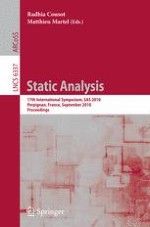2010 | Buch
Static Analysis
17th International Symposium, SAS 2010, Perpignan, France, September 14-16, 2010. Proceedings
herausgegeben von: Radhia Cousot, Matthieu Martel
Verlag: Springer Berlin Heidelberg
Buchreihe : Lecture Notes in Computer Science
